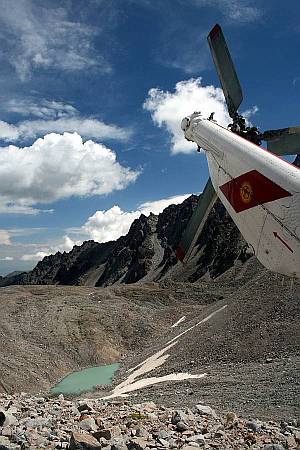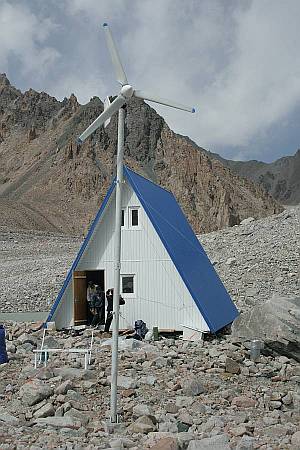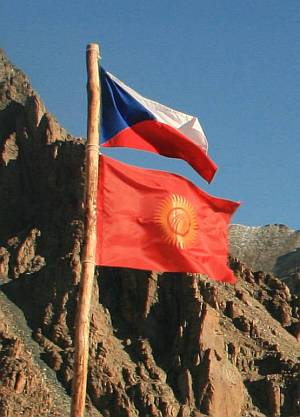HISTORY OF STATION 
Construction of the Adygine research station
A long-term monitoring of a characteristic locality where changes in glaciers cover and development of glacial lakes can be investigated in relation to the climate change and its effect on glaciation was found necessary during the studies of the Kyrgyz alpine lakes. The Adygine locality has been chosen for such studies. It is relatively well-explored and has been monitored by the Czech-Kyrgyz expedition since 2004. It complies with the required criteria such as:
A long-term monitoring of a characteristic locality where changes in glaciers cover and development of glacial lakes can be investigated in relation to the climate change and its effect on glaciation was found necessary during the studies of the Kyrgyz alpine lakes. The Adygine locality has been chosen for such studies. It is relatively well-explored and has been monitored by the Czech-Kyrgyz expedition since 2004. It complies with the required criteria such as:
- altitude above sea level over 3000 m
- presence of alpine lakes at risk
- occurrence of an intensely thawing glacier
- large number of data acquired during earlier investigations
- representativeness for a larger region
- relatively fair accessibility
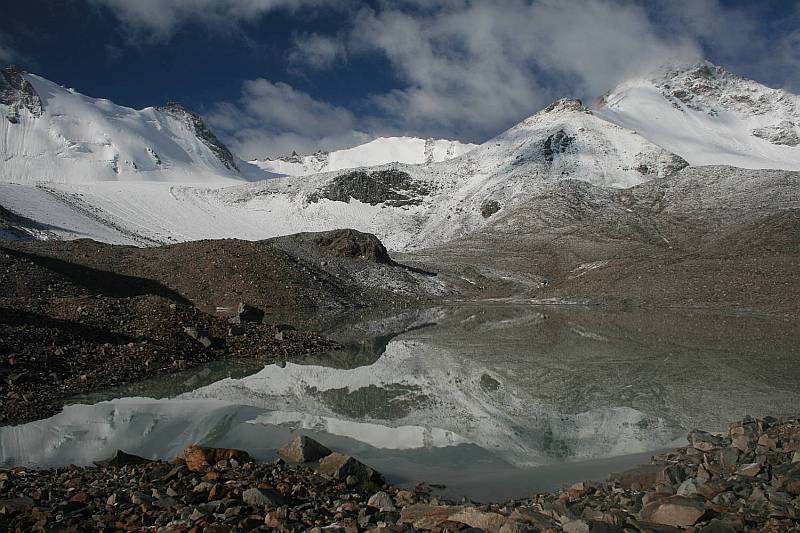
The Adygine locality consist of a large moraine, several lakes and a glacier of the same name on its summit.
The history of the station
The idea of building a research station originated as early as the first Czech-Kyrgyz project during which the research team began to study the relationship between the development of local alpine lakes and climate. This intention was then incorporated as the major objective in a new project proposal. It contained the program of research activities of the station and requirements for its construction and instrumentation.
The locality of Adygine was chosen for construction of the research station at the very beginning of our considerations because it complies with all the above-mentioned criteria. The site for construction of the station was selected on the shore of the Adygine upper lake at an altitude of 3 600 m above sea level. This site lies on bedrock covered by only a thin layer of gravel, which ensures stability in contrast with its environs which are built mostly of a moraine with buried ice. The site is also safe from the viewpoint of possible streams of debris avalanches, avalanches and landslides.
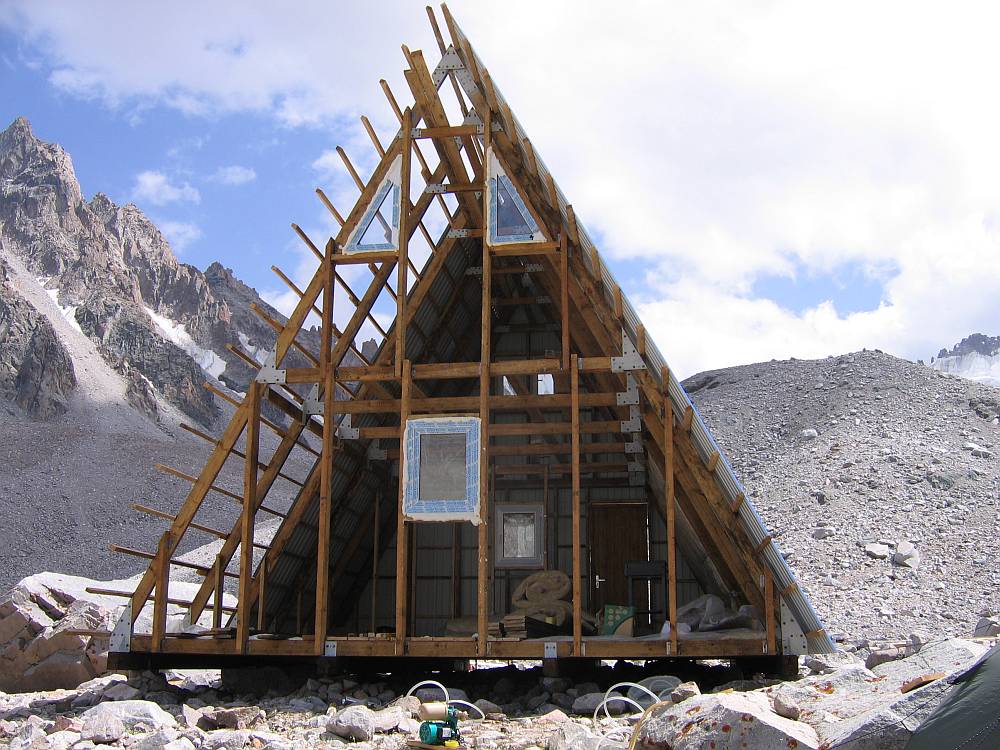
The station under construction as of July 6, 2008
Mr. Pavel A. Jerochin was charged in Kyrgyzstan to design the research station. Some construction elements, facilities, instrumentation and technicalities were in consultation with Czech specialists. The building scheme was worked out during the winter months of 2007/2008, and the plan was continuously modified in the course of time. A private company in Bishkek was hired to manufacture individual construction elements. This company has a group of universal craftsmen that were able to do carpentry, welding, metalworking, masonry and other work.
The craftsmen assembled the whole major construction in a workshop and prepared other construction parts. The construction was then dismantled and together with other material transported in an intermediate storehouse at Baytyk village.
The transport of more than six metric tons of material to the construction site posed the major problem, which could be resolved only by using a helicopter. The only available helicopter in the whole of Kyrgyzstan is in the possession of the Kyrgyzstan Airlines, a state enterprise, which as the sole contractor can dictate terms and prices that are substantially higher than in the neighboring countries. However, helicopters from the neighboring countries are forbidden to fly over Kyrgyzstan except for emergency or transport of mountain climbers in the area of the river Pik Pobeda. Fortunately, the local chopper was found to be in good shape and manned by an experienced pilot. The transport took place on June 24, 2008, and regardless of not very good weather all the material was transported during six flights and deposited on the moraine in close neighborhood of the lake.
Once the material was delivered to the construction site the building of the research station began immediately. The construction proceeded under unfavorable climatic conditions, often during rain or snow, so that all the construction workers deserve to be given words of appreciation. The whole building was completed in mid-July so that the interior could have been furnished.
The work connected with furnishing and instrumentation of the station and outside modifications of the ground were in progress until the autumn months of 2008. Simultaneously, all the equipment was gradually put into operation and the research team began to fulfill the scheduled research program.
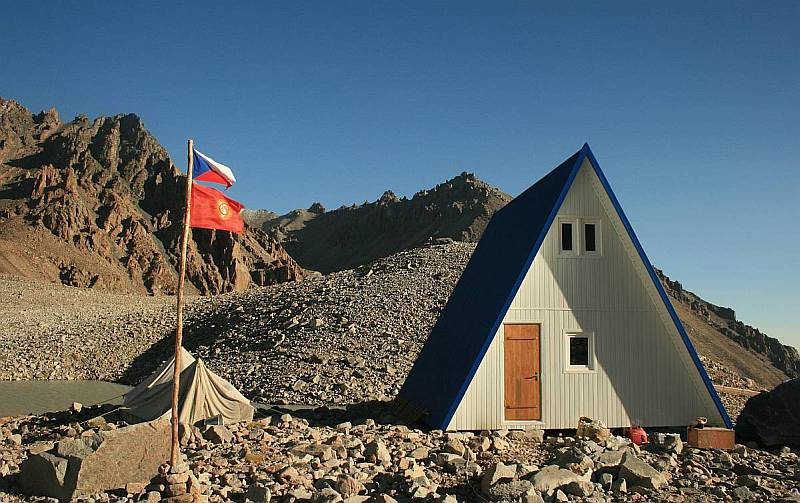
The building of the Adygine research station.
The station is on stable work regime since 2008. The work is interrupted just for several winter months because of savings and security of crew.
The station was officially handed over the Kyrgyzstan in September 2009.
The equipment and facility is completed step by step. The summer kitchen and dining room has been built next to the station in 2012.


